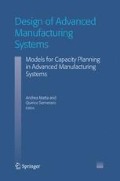Abstract
This chapter presents an innovative approach for assisting entrepreneurs in making long term capacity decisions in Advanced Manufacturing Systems (AMSs). AMSs require high investment costs in manufacturing equipment, human resources and technology knowledge. Such high investments together with the wideness and the variability of the competition scenario contribute to increase the perception of the risk for industrial entrepreneurs especially in SMEs. This problem could be approached by providing the entrepreneur with a Decision Support System (DSS) able to assist her/him in making long term capacity decision in AMS. The DSS proposed in this chapter allows the entrepreneur to plan its production strategy starting from company business strategy, market strategy, competition scenario and outsourcing scenario. Starting from such information, a Fuzzy Expert Systems allows defining the kind of strategic flexibility the company needs and how the company should compose its production mix between internal production and outsourced one. This strategic information represents the input of a Long Term Capacity Planning Model based on economy of scope models that constitutes the economic and financial hearth of the DSS.
Access this chapter
Tax calculation will be finalised at checkout
Purchases are for personal use only
Preview
Unable to display preview. Download preview PDF.
References
Albayrakoglu M. (1996). Justification of new manufacturing technology: a strategic approach using analytical hierarchy process. Production and Inventory Management Journal, 37: 71–77.
Babic, B. (1999). Axiomatic design of flexible manufacturing systems. International Journal of Production Research, 37: 1159–1173.
Banerjee S.K. (2000). Developing manufacturing management strategies: Influence of technology and other issues. International Journal of Production Economics, 64: 79–90.
Bateman N., Stockton D. J., and Lawrences P. (1999). Measuring the mix response flexibility of manufacturing systems. International Journal of Production Research, 37: 871–880.
Berry W.L., Hill T., and Klompmaker J.E. (1999). Aligning marketing and manufacturing strategies with the market. International Journal of Production Research, 37: 3599–3618.
Chan, F. T.S., Jiang B., and Tang, N. K.H. (2000). The development of intelligent decision support tools to aid the design of flexible manufacturing systems. International Journal of Production Economics, 65:73–84.
Chung K.J, and Tsou C.S. (1998). Analysis and algorithm for optimal investment times of new manufacturing technologies in a duopoly. European Journal of Operational Research, 109: 632–645.
Dangl T. (1999). Investment and capacity under uncertain demand. European Journal of Operational Research, 117: 415–428.
De Meyer, A., Nakane, J., and Ferdows, K. (1989). Flexibility: the next competitive battle — the manufacturing futures survey. Strategic Management Journal, 10: 135–144.
Elango, B, and Meinhart, W. A. (1994). Selecting a flexible manufacturing system — a strategic approach”. Long Range Planning, 27: 118–126.
Feurstein M., and Natter M. (2000). Fast high precision decision rules for valuing manufacturing flexibility. European Journal of Operational Research, 120: 108–117.
Fine, C. H., and Freund R. M. (1990). Optimal Investment in Product-Flexible Manufacturing Capacity. Management Science, 36(4): 449–464.
Frazelle, E. H. (1986). Flexibility: a strategic response in changing times. Industrial Engineering, March: 17–20.
Harrison, J. M., and Mieghem, J. A. (1999). Multi-Resource investment strategies: Operational hedging under demand uncertainty. European Journal of Operational Research, 113: 17–29.
Lim S. K., and Kim, Y. D. (1998). Capacity planning for phased implementation of flexible manufacturing systems under budget restrictions. European Journal of Operational Research, 104: 175–186.
Mohanty, R. P. (1993). Analysis of justification problems in CIMS: review and projection. IEE Transactions, 19: 222–232.
Naik B., and Chakravarty, A. K. (1992). Strategic acquisition of new manufacturing technology: a review and research framework. International Journal of Production Research, 30(7): 1575–1601.
Parker, R. P., and Wirth, A. (1999). Manufacturing flexibility: Measures and relationships”. European Journal of Operational Research, 118: 429–449.
Parsei, H. R., and Wilhelm, M. R. (1989). A justification methodology for automated manufacturing technologies. Computers and Industrials Engineering, 16: 363–373.
Perrone, G., and Noto La Diega, S. (1999-a). A Reference Scenario for IMS Strategic Design. Annals of CIRP, 48, 381–384.
Perrone, G., and Noto La Diega S. (1999-b). A Simultaneous Approach for IMS Design: a Possibility Based Approach. Modeling Manufacturing Systems, Springer Verlag.
Price, D.H.R., Beach, R., Muhlemann, A.P., Sharp, J.A., and Paterson, A. (1998). A system to support the enhancement of strategic flexiability in manufacturing enterprises. European Journal of Operational Research, 109: 362–376.
Sarkis J., and Talluri S. (1999). A decision model for evaluation of flexible manufacturing systems in the presence of both cardinal and ordinal factors. International Journal of Production Research, 37: 2927–2938.
Sheng, J., and Sueyoshi, T. (1995). A unified framework for the selection of flexible manufacturing systems. European Journal of Operational Research, 85: 297–315.
Shewchuk J. P. (1999). A set of flexibility measures for manufacturing applications. International Journal of Production Research, 37: 3017–3042.
Tombak, M. M. (1990). A strategic analysis of flexible manufacturing systems. European Journal of Operational Research, 47: 225–238.
Wu B., and Ellis R. (2000). Manufacturing strategy analysis and manufacturing system design: Process and Application. International Journal of Production Economics, 65: 55–77.
Author information
Authors and Affiliations
Editor information
Editors and Affiliations
Rights and permissions
Copyright information
© 2005 Springer
About this chapter
Cite this chapter
Bruccoleri, M., Lo Nigro, G., La Noto Diega, S., Renna, P., Perrone, G. (2005). A DSS for Strategic Planning. In: Matta, A., Semeraro, Q. (eds) Design of Advanced Manufacturing Systems. Springer, Dordrecht. https://doi.org/10.1007/1-4020-2931-4_2
Download citation
DOI: https://doi.org/10.1007/1-4020-2931-4_2
Publisher Name: Springer, Dordrecht
Print ISBN: 978-1-4020-2930-1
Online ISBN: 978-1-4020-2931-8
eBook Packages: EngineeringEngineering (R0)

